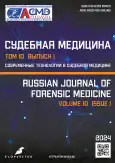Biochipping in forensic medicine as a technology for determining readiness to cause harm: a review
- Authors: Tukenova Z.S.1, Alikperov K.D.2, Begaliyev Y.N.1, Seraliyeva A.M.3, Shayakhmetova Z.B.4
-
Affiliations:
- Academy of Law Enforcement Agencies Under the General Prosecutors Office of the Republic of Kazakhstan
- Center of Legal Research, Baku
- Abai Kazakh National Pedagogical University
- Atyrau university by after Kh. Dosmukhamedov
- Issue: Vol 10, No 1 (2024)
- Pages: 47-55
- Section: Reviews
- URL: https://journals.rcsi.science/2411-8729/article/view/254426
- DOI: https://doi.org/10.17816/fm16092
- ID: 254426
Cite item
Full Text
Abstract
This article evaluated the issues of determining consent to harm as grounds for excluding crime through the prism of the totality of mental and physiological processes in the victim’s body, considering the analysis of the emotional attitude to the traumatic situation. Existing practice is based on the testimony and position of the injured party and the absence of physical signs of resistance as an indicator of consent to harm.
The materials of the study were the norms of the criminal legislation of Kazakhstan and foreign states on the meaning of the victim’s consent to harm his or her peers and interests, particularly in cases of sexual inviolability. A literature review on this topic revealed the relationship between the subjective attitude of the victim of violence and chemical and physiological processes in the body.
The achievements of scientists in determining chemical and physiological signs of stress in real time using bioanalysts-biochips were analyzed. Based on the results, generalization of scientific works, and analysis of legislation on the subject, the evidentiary value of these technologies to determine the consent of the victim in the absence of signs of stress at the time of exposure were considered.
The use of biochips with analyzers of chemical and physiological changes in the human body in real time will not only determine the stress state of the victim at the time of the attack, as a sign of consent or refusal to act, but also expand the possibilities of forensic medicine and general practical medicine in early diagnosis of diseases and prompt treatment. Furthermore, a SWOT analysis of the use of biocyping to resolve the issue of determining the victim’s consent to harm, excluding the possibility of manipulation and falsification of evidence, was performed.
Keywords
Full Text
##article.viewOnOriginalSite##About the authors
Zhanar S. Tukenova
Academy of Law Enforcement Agencies Under the General Prosecutors Office of the Republic of Kazakhstan
Author for correspondence.
Email: tukenovazhanar@mail.ru
ORCID iD: 0009-0001-8256-1121
SPIN-code: 8000-9337
Kazakhstan, Koshy
Khanlar D. Alikperov
Center of Legal Research, Baku
Email: xan_alikperov@hotmail.com
ORCID iD: 0009-0008-7855-8510
SPIN-code: 6706-4825
Dr. Sci. (Legal), Professor
Azerbaijan, BakuYernar N. Begaliyev
Academy of Law Enforcement Agencies Under the General Prosecutors Office of the Republic of Kazakhstan
Email: ernar-begaliev@mail.ru
ORCID iD: 0000-0001-6659-8576
SPIN-code: 1929-3392
Dr. Sci. (Legal), Professor
Kazakhstan, KoshyAliya M. Seraliyeva
Abai Kazakh National Pedagogical University
Email: aliya-mazhitovna@mail.ru
ORCID iD: 0000-0002-3786-8757
SPIN-code: 1151-1080
Cand. Sci. (Legal), Associate Professor
Kazakhstan, AlmatyZhanna B. Shayakhmetova
Atyrau university by after Kh. Dosmukhamedov
Email: jan68@inbox.ru
ORCID iD: 0000-0001-6965-9813
SPIN-code: 2619-4551
Cand. Sci (Legal), Associate Professor
Kazakhstan, AtyrauReferences
- Tursunov AB, Galitsky FA, Begaliev EN, et al. Forensic and forensic aspects of childhood traumatism as a result of domestic injuries and traffic accidents: A review. Russ J Forensic Med. 2023;9(3):299-308. EDN: ORUBFH doi: 10.17816/fm12389
- Clarke S, Foster J. A history of blood glucose meters and their role in self-monitoring of diabetes mellitus. Br J Biomed Sci. 2012;69(2):83-93. doi: 10.1080/09674845.2012.12002443
- Matthews DR, Holman RR, Bown E, et al. Pen-sized digital 30-second blood glucose meter. Lancet. 1987;1(8536):778-779. doi: 10.1016/s0140-6736(87)92802-9
- Aksenova EI, Kamynina NN, Maklakova YA. Expert review: Biosensor systems in medicine. Moscow: Research Institute of Health Care Organisation and Medical Management; 2020. 20 р. (In Russ).
- Trung TQ, Lee NE. Flexible and stretchable physical sensor integrated platforms for wearable human-activity monitoringand personal healthcare. Adv Mater. 2016;28(22):4338-4372. doi: 10.1002/adma.201504244
- Voyevodkin DV, Rustemova GR, Begaliyev YN, et al. Identifying fake conclusions of forensic medical examinations using an artificial intelligence technology based on the experience in the Republic of Kazakhstan: A review. Russ J Forensic Med. 2023;9(3):287-298. EDN: EFNJIE doi: 10.17816/fm8270
- Yoon S, Sim J, Cho YH. A flexible and wearable human stress monitoring patch. Sci Rep. 2016;6:23468. doi: 10.1038/srep23468
- Han J, Yoon S, Lee W, et al. Ionic diffusion-driven ionovoltaic transducer for probing ion-molecular interactions at solid-liquid interface. Adv Sci (Weinh). 2022;9(1):e2103038. doi: 10.1002/advs.202103038
- Kim KH, Bang SW, Kim SR. Emotion recognition system using short-term monitoring of physiological signals. Med Biol Eng Comput. 2004;42(3):419-427. doi: 10.1007/BF02344719
- Alikperov HD. Anti-criminal shield of society (Remote control over crime). In: Measures to counteract the commission of certain types of offences through the chipping of certain categories of persons: Materials of the international scientific-practical conference, 25 Sept 2023. Almaty: Lantar-books, Republic of Kazakhstan; 2023. Р. 31-38. (In Russ).
- Orakbayev AB, Kurmangali ZhK, Begaliyev YeN, et al. ON The issue of using the results of a virtual autopsy in criminal investigation: A review. Russ J Forensic Med. 2023;9(2):183-192. EDN: OEERGD doi: 10.17816/fm774









